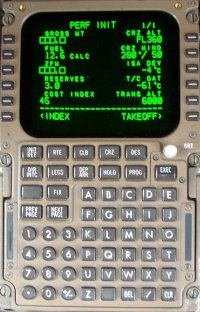Flight Management Navigation - FMS Description
Amendment: FMC Interface Diagram included.
The Flight Management System (FMS) aids the flight crew with navigation, in-flight performance optimisation, automatic fuel monitoring, and flight deck displays. Automatic flight functions manage the airplane lateral flight path (LNAV) and vertical flight path (VNAV). The displays include a map for airplane orientation and command markers on the airspeed, altitude, and thrust indicators to help in flying efficient profiles.
The flight crew enters the applicable route and flight data into the CDUs. The FMS then uses the navigation database, airplane position, and supporting systems to calculate commands for manual and automatic flight path control.
The FMS tunes the navigation radios for position updating. The FMS navigation database supplies the necessary data to fly routes, SIDs, STARs, holding patterns, and procedure turns. Cruise altitudes and crossing altitude restrictions are used to calculate VNAV commands. Lateral offsets from the programmed route can be calculated and commanded.
Flight Management Computer
The heart of the flight management system is the Flight Management Computer (FMC). Under normal conditions, one FMC accomplishes the flight management tasks while the other FMC monitors. The second FMC is ready to replace the first FMC if system faults occur.

The FMC uses flight crew-entered flight plan data, airplane systems data, and data from the navigation database to calculate airplane present position and generate the pitch, roll, and thrust commands necessary to fly an optimum flight profile. The FMC sends these commands to the Autothrottle, autopilot, and flight director. Map and route data are sent to the HSIs. The EFIS control panels are used to select the data to be displayed on the HSIs. The mode control panel selects the Autothrottle, Autopilot, and Flight Director operating modes. Refer to the following sections for operation of these other systems:
The FMC is certified for area navigation when used with updating from navigation radios or the GPS if installed.
The FMC and CDU are used for enroute and terminal area navigation, RNAV approaches, and as a supplement to primary navigation means when conducting other types of non-precision approaches.
Control Display Units

Two Control Display Units (CDUs) are used to control the FMC.
The CDUs also provide alternate navigation capability if both FMCs fail (See: Alternate Navigation System). The CDUs can also provide control of other systems which are accessed through the menu page.
Entries made from either CDU are sent to both computers. Because of this interconnection, to prevent confusion it is recommended that only one CDU at a time be used for entering information. The second CDU is best used as a monitor to check information being entered on the other CDU.
Note: The Alternate Navigation facility is only available on aircraft equipped with Hybrid CDUs and rotary Nav Instrument Source Selectors.